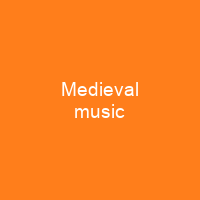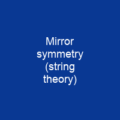Medieval music includes solely vocal music, Gregorian chant and choral music, solely instrumental music, and music that uses both voices and instruments. It is the first and longest era of Western classical music and followed by the Renaissance music. Many instruments used to perform medieval music still exist in the 21st century, but in different and typically more technologically developed forms.
About Medieval music in brief
 Medieval music includes solely vocal music, such as Gregorian chant and choral music, solely instrumental music, and music that uses both voices and instruments. It is the first and longest era of Western classical music and followed by the Renaissance music. During the Medieval period the foundation was laid for the music notation and music theory practices that would shape Western music into the norms that developed during the common practice period. Many instruments used to perform medieval music still exist in the 21st century, but in different and typically more technologically developed forms. Medieval music used many plucked string instruments like the lute, a fretted instrument with a pear-shaped hollow body which is the predecessor to the modern guitar. The flute was made of wood in the medieval era rather than silver or other metal, and could be made as a side-blown or end-blown instrument. While modern orchestral flutes are usually made of metal and have complex key mechanisms and airtight pads, medieval flutes had holes that the performer had to cover with the fingers. The bowed lyra of the Byzantine Empire was the first recorded European bowed string instrument. Like the modern violin, a performer produced sound by moving a bow with tensioned hair over tensioned strings. The hurdy-gurdy was a mechanical violin using a rosined crank to attach to a wooden wheel to string its strings. Early music was composed and improvised for some modern music, including the harp, trombone, and a precursor to the harpsichord.
Medieval music includes solely vocal music, such as Gregorian chant and choral music, solely instrumental music, and music that uses both voices and instruments. It is the first and longest era of Western classical music and followed by the Renaissance music. During the Medieval period the foundation was laid for the music notation and music theory practices that would shape Western music into the norms that developed during the common practice period. Many instruments used to perform medieval music still exist in the 21st century, but in different and typically more technologically developed forms. Medieval music used many plucked string instruments like the lute, a fretted instrument with a pear-shaped hollow body which is the predecessor to the modern guitar. The flute was made of wood in the medieval era rather than silver or other metal, and could be made as a side-blown or end-blown instrument. While modern orchestral flutes are usually made of metal and have complex key mechanisms and airtight pads, medieval flutes had holes that the performer had to cover with the fingers. The bowed lyra of the Byzantine Empire was the first recorded European bowed string instrument. Like the modern violin, a performer produced sound by moving a bow with tensioned hair over tensioned strings. The hurdy-gurdy was a mechanical violin using a rosined crank to attach to a wooden wheel to string its strings. Early music was composed and improvised for some modern music, including the harp, trombone, and a precursor to the harpsichord.
Early harp was composed by some medieval monks, and was composed for some secular music. The high medieval era began to develop during the early 13th century, becoming prevalent by the early 14th century. Polyphonic genres, in which multiple melodic lines are performed simultaneously, became prevalent during the late medieval era, becoming popular by the 13th and 14th centuries. The medieval genre, predominantly liturgical, was done by monks, monophonic chant, and liturgical chant was predominantly done by Gregorian monks. The early medieval era also saw the development of the organ, which was popular for some early medieval music, as well as for some non-religious music such as the shilyani and the salandj. Early medieval music was written by composers, except for some instrumental music which was improvised, except by some sacred and secular composers. The most significant of these is the music notational system which enabled composers to write out their song melodies and instrumental pieces on parchment or paper. The development of music notation made it easier to disseminate songs and musical pieces to a larger number of people and to a wider geographic area. The Persian geographer Ibn Khurradadhbih of the 9th century cited the Byzantine lyra, in his lexicographical discussion of instruments as a bowed instrument equivalent to the Arab rabāb and typical instrument of the Byzantines along with the urghun, shallyani and the Salandj.
You want to know more about Medieval music?
This page is based on the article Medieval music published in Wikipedia (as of Dec. 10, 2020) and was automatically summarized using artificial intelligence.







